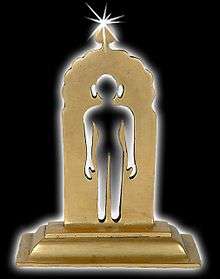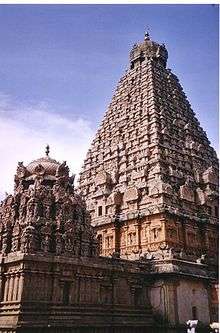Siddha
Siddha (Tamil 'Great thinker/wise man', Sanskrit, "perfected one") is a term that is used widely in Indian religions and culture. It means "one who is accomplished".[1][2] It refers to perfected masters who have achieved a high degree of physical as well as spiritual perfection or enlightenment. In Jainism, the term is used to refer the liberated souls. Siddha may also refer to one who has attained a siddhi, paranormal capabilities.
Siddhas may broadly refer to siddhars, naths, ascetics, sadhus, or yogis because they all practice sādhanā.[3]
The Svetasvatara (II.12) presupposes a 'Siddha body.[4]
Jainism


In Jainism, the term siddha is used to refer the liberated souls who have destroyed all karmas and have obtained moksha.[5] They are free from the transmigratory cycle of birth and death (saṃsāra) and are above Arihantas (omniscient beings). Siddhas do not have a body; they are soul in its purest form. They reside in the Siddhashila, which is situated at the top of the Universe.[6] They are formless and have no passions and therefore are free from all temptations. They do not have any karmas and they do not collect any new karmas.
According to Jains, Siddhas have eight specific characteristics or qualities. Ancient Tamil Jain Classic 'Choodamani Nigandu' describes the eight characteristics in a beautiful poem, which is given below.[7]
"கடையிலா ஞானத்தோடு காட்சி வீரியமே இன்ப
மிடையுறு நாமமின்மை விதித்த கோத்திரங்களின்மை
அடைவிலா ஆயுஇன்மை அந்தராயங்கள் இன்மை
உடையவன் யாவன் மற்று இவ்வுலகினுக்கு இறைவனாமே"
"The soul that has infinite knowledge (Ananta jnāna, கடையிலா ஞானம்), infinite vision or wisdom (Ananta darshana, கடையிலா காட்சி), infinite power (Ananta labdhi, கடையிலா வீரியம்), infinite bliss (Ananta sukha, கடையிலா இன்பம்), without name (Akshaya sthiti, நாமமின்மை), without association to any caste (Being vitāraga, கோத்திரமின்மை), infinite life span (Being arupa, ஆயுள் இன்மை) and without any change (Aguruladhutaa, அழியா இயல்பு) is God."
The following table summarizes the eight supreme qualities of a liberated soul.[8]
| Quality | Meaning | Manifestation |
|---|---|---|
| Kśāyika samyaktva | infinite faith or belief in the tattvas or essential principles of reality | manifested on the destruction of the faith-deluding (darśana mohanīya) karma |
| Kevala Jnāna | infinite knowledge | on the destruction of the knowledge-obscuring (jnānāvarnīya) karma. |
| Kevaladarśana | infinite perception | on the destruction of the perception-obscuring (darśanāvarnīya) karma |
| Anantavīrya | infinite power | on the destruction of the obstructive (antarāya) karma |
| Sūksmatva | fineness | manifested on the destruction of the life- determining (āyuh) karma |
| Avagāhan | inter-penetrability | manifested on the destruction of the name-determining (nāma) karma |
| Agurulaghutva | literally, neither heavy nor light | manifested on the destruction of the status-determining (gotra) karma |
| Avyābādha | undisturbed, infinite bliss | manifested on the destruction of the feeling-producing (vedanīya) karma |
Because of the quality of Sūksmatva, the liberated soul is beyond sense-perception and its knowledge of the substances is direct, without the use of the senses and the mind. The quality of avagāhan means that the liberated soul does not hinder the existence of other such souls in the same space.
A soul after attaining Siddhahood goes to the top of the loka (as per jain cosmology) and stays there till infinity. Siddhas are formless and dwell in Siddhashila with the above mentioned eight qualities.
Thiruvalluvar in his Tamil book Thirukural refers to the eight qualities of God,[9] in one of his couplet poems.
Hinduism
In Hinduism, the first usage of the term Siddha occurs in the Maitreya Upanishad in chapter Adhya III where the writer of the section declares "I am Siddha."
Siddha or siddhar (Tamil tradition)
| Part of a series on |
| History of Tamil Nadu |
|---|
 |
In Tamil Nadu, South India, a siddha (see Siddhar) refers to a being who has achieved a high degree of physical as well as spiritual perfection or enlightenment. The ultimate demonstration of this is that siddhas allegedly attained physical immortality. Thus siddha, like siddhar, refers to a person who has realised the goal of a type of sadhana and become a perfected being. In Tamil Nadu, South India, where the siddha tradition is still practiced, special individuals are recognized as and called siddhas (or siddhars or cittars) who are on the path to that assumed perfection after they have taken special secret rasayanas to perfect their bodies, in order to be able to sustain prolonged meditation along with a form of pranayama which considerably reduces the number of breaths they take. Siddha were said to have special powers including flight. These eight powers are collectively known as attamasiddhigal (ashtasiddhi). In Hindu cosmology, Siddhaloka is a subtle world (loka) where perfected beings (siddhas) take birth. They are endowed with the eight primary siddhis at birth.
The well-known 18 siddhars are listed below.
- Agasthiyar
- Kamalamuni
- Thirumoolar
- Kuthambai
- Korakkar
- Thanvandri
- Konganar
- Sattamuni
- Vanmeegar
- Ramadevar
- Nandeeswarar (Nandidevar)
- Edaikkadar
- Machamuni
- Karuvoorar
- Bogar
- Pambatti Siddhar
- Sundarandandar
- Patanjali
Kashmir Shaivism
In the Hindu philosophy (of Kashmir Shaivism), siddha refers to a Siddha Guru who can by way of Shaktipat initiate disciples into Yoga. A Siddha, in Tamil Siddhar or Chitthar (see Chit/Consciousness), means "one who is accomplished" and refers to perfected masters who, according to Hindu belief, have transcended the ahamkara (ego or I-maker), have subdued their minds to be subservient to their Awareness, and have transformed their bodies (composed mainly of dense Rajotama gunas) into a different kind of body dominated by sattva. This is usually accomplished only by persistent meditation.
Siddhashrama
In Hindu theology, Siddhashrama is a secret land deep in the Himalayas, where great yogis, sadhus and sages who are siddhas live. The concept is similar to Tibetan mystical land of Shambhala.
Siddhashrama is referred in many Indian epics and Puranas including Ramayana and Mahabharata. In Valmiki's Ramayana it is said that Viswamitra had his hermitage in Siddhashrama, the erstwhile hermitage of Vishnu, when he appeared as the Vamana avatar. He takes Rama and Lakshmana to Siddhashrama to exterminate the rakshasas who are disturbing his religious sacrifices (i.28.1-20).[10][11]
Siddha Sampradaya
_-_Virupa_16_century_Private_coll..jpg)
Whenever siddha is mentioned, the 84 siddhas and 9 nathas are remembered, and it is this tradition of siddha which is known as the Nath tradition. Siddha is a term used for both mahasiddhas and naths So a siddha may mean a siddha, a mahasiddha or a nath. The three words are used interchangeably.
The eighty-four Siddhas in the Varna(na)ratnakara
A list of eighty-four siddhas is found in a manuscript (manuscript no 48/34 of the Asiatic Society of Bengal) dated Lakshmana Samvat 388 (1506) of a medieval Maithili work, the Varna(na)ratnākara written by Jyotirishwar Thakur, the court poet of King Harisimhadeva of Mithila (reigned 1300–1321). An interesting feature of this list is that the names of the most revered naths are incorporated in this list along with Buddhist siddhācāryas. The names of the siddhas found in this list are:[12][13]
- Minanātha
- Gorakshanātha
- Chauranginātha
- Chāmarinātha
- Tantipā
- Hālipā
- Kedāripā
- Dhongapā
- Dāripā
- Virupā
- Kapāli
- Kamāri
- Kānha
- Kanakhala
- Mekhala
- Unmana
- Kāndali
- Dhovi
- Jālandhara
- Tongi
- Mavaha
- Nāgārjuna
- Dauli
- Bhishāla
- Achiti
- Champaka
- Dhentasa
- Bhumbhari
- Bākali
- Tuji
- Charpati
- Bhāde
- Chāndana
- Kāmari
- Karavat
- Dharmapāpatanga
- Bhadra
- Pātalibhadra
- Palihiha
- Bhānu
- Mina
- Nirdaya
- Savara
- Sānti
- Bhartrihari
- Bhishana
- Bhati
- Gaganapā
- Gamāra
- Menurā
- Kumāri
- Jivana
- Aghosādhava
- Girivara
- Siyāri
- Nāgavāli
- Bibhavat
- Sāranga
- Vivikadhaja
- Magaradhaja
- Achita
- Bichita
- Nechaka
- Chātala
- Nāchana
- Bhilo
- Pāhila
- Pāsala
- Kamalakangāri
- Chipila
- Govinda
- Bhima
- Bhairava
- Bhadra
- Bhamari
- Bhurukuti
The Siddhas in the Hatha Yoga Pradipika
In the first upadeśa (chapter) of the Hatha Yoga Pradipika, a 15th-century text, a list of yogis is found, who are described as the Mahasiddhas. This list has a number of names common with those found in the list of the Varna(na)ratnākara:[12][14]
- Ādinātha
- Matsyendra
- Śāvara
- Ānandabhairava
- Chaurangi
- Minanātha
- Gorakṣanātha
- Virupākṣa
- Bileśaya
- Manthāna
- Bhairava
- Siddhibuddha
- Kanthaḍi
- Koraṃṭaka
- Surānanda
- Siddhapāda
- Charpaṭi
- Kānerī
- Pūjyapāda
- Nityanātha
- Nirañjana
- Kapālī
- Bindunātha
- Kākachaṇḍīśvarā
- Allāma
- Prabhudeva
- Ghoḍā
- Chholī
- Ṭiṃṭiṇi
- Bhānukī
- Nāradeva
- Khaṇḍakāpālika
See also
- Kagapujandar
- Religion in ancient Tamil country
- Sandha language
- Cit "absolute consciousness"
- Sage (philosophy)
References
- ↑ "Definition: Mahasiddha (Indian Adept) & Siddha Appearance". http://www.himalayanart.org. External link in
|journal=(help) - ↑ "Siddha-asana The accomplished or adept pose". http://www.santosha.com. External link in
|journal=(help) - ↑ Zimmermann, Marion (2003). A short introduction: The Tamil Siddhas and the Siddha medicine of Tamil Nadu. GRIN Verlag. p. 4. ISBN 9783638187411.
- ↑ P. 156 Buddhist sects and sectarianism By Bibhuti Baruah
- ↑ "The purpose of life in Jainism". http://www.religionfacts.com. External link in
|journal=(help) - ↑ "Jainism Cosmology". http://www.hinduwebsite.com. External link in
|journal=(help) - ↑ J. Srichandran(1981),ஜைன தத்துவமும் பஞ்ச பரமேஷ்டிகளும், Vardhamanan Padhipakam, Chennai, Page 18
- ↑ Jain, Vijay K (2014-03-26). Acarya Pujyapada's Istopadesa – the Golden Discourse. p. 5. ISBN 9788190363969.
- ↑ Ashraf, N.V.K. Tirukkural: Getting close to the original In Spirit, Content and Style, http://web.archive.org/web/20080630190537/http://www.geocities.com/nvashraf/kureng/close01.htm, accessed on 22 March 2008
- ↑ Vyas, R.T. (ed.) (1992). Vālmīki Rāmāyaṇa, Text as Constituted in its Critical Edition. Vadodara: Oriental Institute, Vadodara. p. 40.
- ↑ Hanumanta Rao, Desiraju (1998). "Valmiki Ramayana, Bala Kanda, Chapter 29". valmikiramayan.net website. Retrieved 2009-10-21.
- 1 2 Dasgupta, Sashibhusan (1995). Obscure Religious Cults, Firma K.L.M., Calcutta, ISBN 81-7102-020-8, pp.203ff, 204
- ↑ Shastri Haraprasad (ed.) (1916, 3rd edition 2006). Hajar Bacharer Purano Bangala Bhasay Bauddhagan O Doha (in Bengali), Kolkata: Vangiya Sahitya Parishad, pp.xxxv-vi
- ↑ Sinh, Pancham (tr.) (1914). "Hatha Yoga Pradipika, Chapter 1". sacred-texts.com website. Retrieved 2009-11-12.
External links
| Wikimedia Commons has media related to Siddha. |
